
File:Piles of Salt Salar de Uyuni Bolivia Luca Galuzzi 2006 a.jpg

Size of this preview: 640 × 422 pixels.
| |
This is a featured picture, which means that members of the community have identified it as one of the finest images on the English Wikipedia, adding significantly to its accompanying article. If you have a different image of similar quality, be sure to upload it using the proper free license tag, add it to a relevant article, and nominate it. |
| |
This image was selected as picture of the day on the English Wikipedia for July 29, 2007. |
File usage
The following pages on Schools Wikipedia link to this image (list may be incomplete):
Metadata
A background to Schools Wikipedia
Wikipedia for Schools brings Wikipedia into the classroom. SOS Children's Villages works in 133 countries and territories across the globe, helps more than 62,000 children, and reaches over 2 million people in total. If you'd like to help, learn how to sponsor a child.
Categories:


